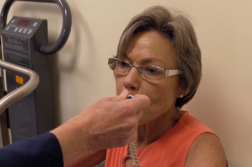ORLANDO, Fla. (Ivanhoe Newswire) — According to the American Diabetes Association, about 1.25 million Americans have type 1 diabetes. Identifying patients who are at risk for the disease could help improve outcomes. Now, scientists have discovered a new way to forecast who will develop type 1 diabetes.
Each year, about 40 thousand children and adults in the United States will be told they have type 1 diabetes. It’s a disease that causes your body’s immune system to attack special cells in the pancreas that normally make insulin.
“So you have no insulin in the body. Insulin is an important hormone that’s needed to live,” said Satish Garg, MD, Endocrinologist, University of Colorado School of Medicine.
Identifying whether a child will develop type 1 diabetes is important because it could help doctors spot the condition before it becomes severe. The problem is it’s tricky to diagnose.
“Even with type 1 diabetes, it takes a long time before the disease manifests,” Dr. Garg continued.
Currently, doctors use a method that measures islet (eye-let) autoantibodies in the blood. But it’s expensive and hard to perform on kids. Now researchers at the University of Exeter have found a new test that is nearly twice as effective at identifying babies who will develop type 1 diabetes. To create it, scientists analyzed genetic variations and interactions across the entire genome of 6,581 people with type 1 diabetes. This helped them pinpoint genetic elements that predict diabetes. Some symptoms of type 1 diabetes: thirst, frequent urination, hunger, weight loss, irritability, fatigue, weakness, bed-wetting in kids, and blurred vision. Researchers say the new risk score could also help them distinguish between type 1 and type 2 diabetes so patients get the right diagnosis and the best treatment possible.
While type 1 diabetes has been traditionally thought of as a “childhood disease,” this same research team discovered that half of all cases develop in adulthood and can often be misdiagnosed. Doctors hope that they might one day be able to find a way to prevent type 1 diabetes altogether in people who are at high-risk of developing it.
Contributors to this news report include: Julie Marks, Field Producer; Roque Correa, Editor.
Free weekly e-mail on Medical Breakthroughs from Ivanhoe. To sign up: http://www.ivanhoe.com/ftk
TYPE 1 DIABETES PREDICTOR
REPORT #2643
BACKGROUND: According to the CDC, more than 100 million adults in the United States are living with diabetes or prediabetes. They note that in 2015, 30.3 million Americans had diabetes. Of that amount, the American Diabetes Association (ADA) estimates 7.2 million didn’t know they had it. Diabetes diagnoses for Americans age 18 and older are increasing, with new diagnoses in all types (pre-diabetes, type 1 and type 2) occurring at about 1.5 million per year. Those numbers were equal for men and women. Previously known as juvenile diabetes, type 1 diabetes is usually diagnosed in childhood. Only about 5 percent of people with diabetes have type 1. While factors such as genetics and certain viruses may contribute to this disease, its exact cause is unknown. There’s no current cure or any known prevention, but there are treatments to help manage symptoms. With type 1 diabetes, the pancreas can’t produce insulin. According to the ADA, 1.25 million Americans have this disorder and around 40,000 people receive a type 1 diagnosis each year in the United States.
(Source: https://dlife.com/diabetes-facts-statistics-and-you/)
DIAGNOSING DIABETES: A fasting plasma glucose test measures your blood glucose after you have gone at least 8 hours without eating. This test is used to detect diabetes or pre-diabetes. An oral glucose tolerance test measures your blood sugar after you have gone at least eight hours without eating and two hours after you drink a glucose-containing beverage and can also be used to diagnose diabetes or pre-diabetes. In a random plasma glucose test, your doctor checks your blood sugar without regard to when you ate your last meal. This test, along with an assessment of symptoms, is used to diagnose diabetes, but not pre-diabetes. The following symptoms can mean you have diabetes: increased urination, increased thirst, unexplained weight loss, fatigue, blurred vision, increased hunger and sores that do not heal. Positive test results should be confirmed by repeating the fasting plasma glucose test or the oral glucose tolerance test on a different day.
(Source: https://www.webmd.com/diabetes/guide/diagnosis-diabetes#2)
BREAKTHROUGH IN DIABETES TREATMENT: Dr. George Gittes, a professor of surgery and of pediatrics at the University of Pittsburgh School of Medicine in Pennsylvania may have found a way to restore normal blood glucose levels in a mouse model of type 1 diabetes, which could prove to be a promising solution for people with type 1 or type 2 diabetes in the future. This new study demonstrates that a gene therapy approach can lead to long-term survival of functional beta cells as well as normal blood glucose levels for extended periods of time in mice with type 1 diabetes. Researchers used an adeno -associated viral (AAV) vector to deliver to the mouse pancreas two proteins, Pdx1 and MafA , which reprogrammed the alpha cells into functional, insulin-producing beta cells. Beta-cell replacement therapy is likely to fail because adding new cells will fall victim to the same autoimmunity that destroyed the original cells. The solution is to reprogram other cell types to functional beta-like cells, which can produce insulin but are distinct from beta cells and therefore are not attacked by the immune system. The reason why alpha cells were picked to reprogram is because they are plentiful, resemble beta cells, and are in the correct location, all of these factors facilitate reprogramming of cells. The gene therapy produced normal blood glucose levels in diabetic mice, for typically four months.
(Source: https://diabetestalk.net/diabetes/diabetes-breakthrough-2018)
* For More Information, Contact:
David Kelly



